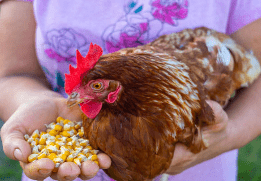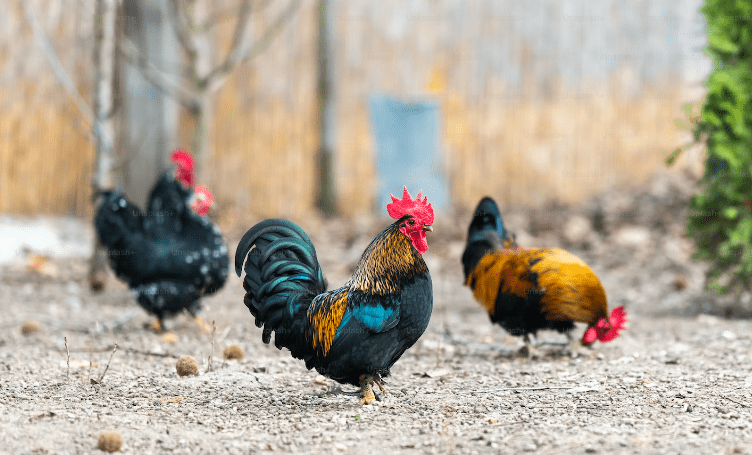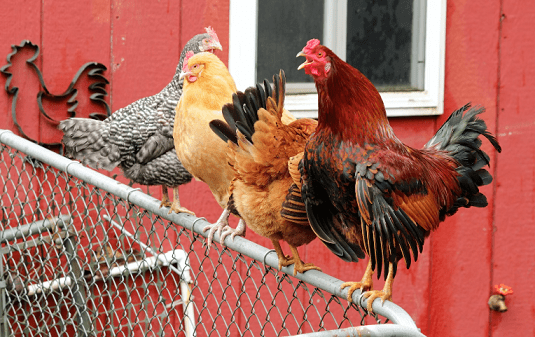Are you puzzled when staring at a fluffy silkie rooster and a silkie hen?
You’re not alone!
As someone who’s delved deep into the poultry world, I can attest to the intriguing aspects of these feathery creatures.
Both captivating and often confusing, understanding the differences between the silkie rooster and hen can feel like deciphering a puzzle.
But worry not; with my guidance in understanding silkie rooster vs hen, you’ll soon become a maestro in all things Silkie.
So, let’s dive into the feathery maze!
Table of Contents
History and Origin of the Silkie Breed
The Silkies emerge as a truly unique specimen from the rich tapestry of chicken breeds. Tracing their history and understanding their origin offers a fascinating tale and sets the backdrop for our detailed comparison of the silkie hen vs rooster.
A Brief History
Silkie chickens have enchanted humans for centuries with their distinctive fluffy feathers and gentle demeanor. Originating from Asia, they made notable appearances in ancient Chinese writings, revealing their storied past.
Cultural Significance: Silkie Chickens in Folklore and Myths
Have you ever heard tales of mythical birds with healing properties? The Silkie chicken, often viewed with mysticism, was esteemed in many cultures. They weren’t just simple poultry; in folklore, they symbolized prosperity and health, particularly in traditional Chinese medicine.
Types of Silkie Chickens
When speaking of Silkies, many imagine a monolithic appearance. In reality, there’s a colorful array of Silkie types, each with its unique charm.
Spotlight on the White Silkie Rooster
Among the variants, the white silkie rooster stands out, not merely for its pristine plumage but also for its prominence in many cultures. This rooster is adored for its regal appearance and often associated with purity, so this rooster commands attention wherever it struts.
Silkie Rooster vs Hen: Physical Differences
When observing a silkie rooster and a silkie hen, the trained eye might initially struggle to pinpoint the distinct differences. Physical contrasts, though subtle, are crucial in distinguishing these feathery friends.
Feather Structure
Silkies are celebrated for their unique, fluffy feathers. While both roosters and hens share this trait, a keen observer might notice certain nuances between them.
Feathers and Plumage: What Sets Them Apart
While both silkie roosters and hens flaunt a soft, downy texture, the roosters often exhibit a slightly more iridescent sheen. Additionally, the pattern and fullness of their plumage can offer hints about their gender, with roosters typically showcasing a grander, more pronounced display.
Comb and Wattle Anatomy
Combs and wattles are vital gender indicators in most chicken breeds, and Silkies are no exception. Though their fluffy appearance might mask these features, they’re there if you know where to look.
Scientific Explanation: How Gender Affects Anatomy
It’s intriguing how biology plays its part. Male silkie roosters have larger, more prominent combs compared to the subtle, smaller combs of the hens. The wattles of roosters are also usually more noticeable, giving an insight into the bird’s gender long before behavioral traits emerge.
Spurs and Feet
Beyond feathers and facial features, the legs of these birds can be telling. Spurs, in particular, are often a definitive gender marker.
An In-Depth Look: How Many Toes Do They Have?
A quirky feature of Silkies is their toe count. Unlike many other chicken breeds, silkie roosters and hens possess five toes. However, roosters tend to have more pronounced spurs, which develop as they age.
Size and Weight
Size often matters when discerning between a silkie rooster and a hen. But with Silkies, the differences might be more nuanced than glaringly evident.
What Age Does Silkie Roosters Reach Their Full Size?
Interestingly, silkie roosters reach their full size in 8-10 months. They’re generally more robust and slightly heavier than hens, providing another layer to the silkie rooster vs hen differentiation puzzle.
Silkie Rooster vs Hen: Physical Differences – Summary Table
| Feature | Silkie Rooster | Silkie Hen |
| Feather Structure | Iridescent sheen, fuller | Soft, downy |
| Comb and Wattle | Larger combs, prominent | Subtle, smaller combs |
| Spurs and Feet | Pronounced spurs | Smaller spurs, less evident |
| Size and Weight | Robust, heavier | Lighter |
| Age at Full Size | 8-10 months | Slightly later |
Behavioral Characteristics
Exploring beyond the exterior, the behavioral traits between silkie rooster and hen offer intriguing revelations.
General Behavior: Hens vs Roosters
Both Silkies are known for their congenial nature. However, subtle differences in behavior often distinguish them.
Social Dynamics Within the Flock
Roosters usually play the guardian role, while hens exhibit motherly tendencies, particularly around their young.
Are Silkie Roosters Friendly or Aggressive?
Silkie roosters defy the aggressive stereotype common to many roosters.
Silkie Roosters vs Other Breeds
In comparison to other breeds, silkie roosters are predominantly gentle. Yet, individual temperaments can differ.
Protective Nature: Who Guards the Flock?
The protective mantle in the avian world is fascinating, with both roosters and hens playing their part.
Real-Life Case Studies
Stories abound of silkie roosters bravely defending their flock against potential threats. These acts of valor, combined with the hen’s protective instincts over her brood, make Silkies a well-rounded, cohesive unit.
Crowing Patterns
Roosters are renowned for their dawn serenades. But what about the silkie rooster?
When Do They Start?
Most silkie roosters commence their crowing as they approach maturity, around 5-7 months. Their crow is distinctive, often softer and more melodic compared to other breeds.
How Loud Can They Get?
While Silkies aren’t the loudest in the poultry kingdom, their vocal expressions still hold their own unique charm. Both silkie roosters and hens communicate through a variety of sounds, painting an audible picture of their daily life.
Behavioral Characteristics – Summary Table
| Behavior | Silkie Rooster | Silkie Hen |
| General Behavior | Dominant, protective | Nurturing, tends to eggs/chicks |
| Aggression Level | Generally docile | Calm, rarely aggressive |
| Protectiveness | Guards the flock, brave defender | Protective of brood |
| Vocal Expressions | Soft, melodic crowing | Various vocalizations, less pronounced |
| Interaction within Flock | Maintains order, dominant | More passive, social |
Health and Longevity of Silkie Roosters
Health is paramount, regardless of whether it’s a silkie rooster or a hen. Their well-being plays a pivotal role in their longevity, productivity, and overall quality of life.
Common Health Issues
While Silkies are generally robust, they aren’t immune to common poultry ailments. Knowing these can assist in early detection and treatment.
- Avian Influenza: A viral disease that can rapidly spread, affecting respiratory and digestive systems.
- Marek’s Disease: Caused by a herpes virus, it affects the nervous system, leading to paralysis in some birds.
- Coccidiosis: A parasitic disease that impacts the digestive system.
- Infectious Bronchitis: Primarily a respiratory disease, it can also affect the reproductive system in hens.
- Fowl Pox: Characterized by scab-like lesions on unfeathered skin areas.
- Lice and Mites: External parasites that can cause discomfort and stress.
- Egg Binding: A condition in hens where an egg gets stuck in the reproductive tract.
- Vent Gleet: A fungal infection affecting the cloaca, causing inflammation and discharge.
- Bumblefoot: Inflammation of a chicken’s foot pad, usually due to a bacterial infection.
- Ascites: Fluid accumulation in the abdomen, often linked to heart or liver disease.
Lifespan: Who Lives Longer Silkie Rooster vs Hen?
It’s a widely held belief that hens generally outlive roosters. However, the lines blur a little when comparing the lifespan of a silkie hen vs rooster. Both can live up to 7-9 years with proper care, although individual life spans can vary based on genetics, health, and environment.
Nutritional Needs
Silkies, with their distinct characteristics, require particular attention to their diet.

Diet Specifics for Silkie Roosters
Silkie roosters, like hens, have a unique diet:
- Layer Pellets: Beneficial in moderation.
- Grit: Aids in digestion.
- Fresh Vegetables: Healthy greens keep them active.
- Protein Sources: Insects and mealworms are their favorite.
- Fresh Fruits: They love apples and berries; however, citrus is a no-go.
- Healthy Grains: Offer them oats and barley occasionally.
- Calcium Supplements: Helps strengthen bones.
- Fresh Water: Must be available at all times.
- Scratch Grains: Serve in limited amounts.
- Vitamin and Mineral Supplements: Ensures they get all required nutrients.
What NOT to Feed Silkie Roosters
Certain foods can be harmful:
- Chocolate: Toxic to birds.
- Avocado: Contains persin, harmful for them.
- Caffeine: Can overstimulate their heart.
- Alcohol: Not suitable for their nervous system.
- Salty Foods: Can lead to sodium ion poisoning.
- Onions & Garlic: Can upset their digestion.
- Raw Potatoes & Dry Beans: Contains harmful toxins.
- Citrus Fruits: Interferes with calcium absorption.
Hydration and Feeding Habits
Always ensure they have access to clean, fresh water, especially in extreme temperatures.
Practical Concerns
Navigating the practical aspects of raising Silkie roosters is crucial.
Cooping and Space Requirements
For Silkies, a spacious and secure coop is essential.

Ideal Living Conditions: Pen vs Free-Range
While penned environments offer safety, free-ranging allows natural behaviors. Balance is key.
Breeding Potential: Can Silkie Roosters Breed with Other Hens?
Yes, they can. The outcome? A unique hybrid!
Hybrid Chickens: What to Expect
Expect a mix of Silkie’s fluffy appearance with traits of the other breed. A delightful surprise awaits.
Conclusion
The mystique of the silkie rooster and hen has fascinated enthusiasts for years. Beyond their whimsical appearance lies a breed rich in history, versatile in breeding potential, and requiring specific care considerations.
Whether you’re a seasoned poultry keeper or just starting, understanding the intricacies of this breed will ensure a rewarding experience.
FAQs
What is the genetic basis for the silkie breed’s distinctive features, such as their fluffy feathers and black skin?
Silkie breed’s features result from specific genetic mutations selectively bred over generations.
What are the unique challenges and rewards of raising silkie roosters?
Raising silkie roosters requires special cooping, but they offer a docile nature and unique aesthetics.
How can silkie roosters be best integrated into a mixed-breed flock?
Silkie roosters integrate well with proper introductions and monitoring, though they may need protection from aggressive flock members.
What are some of the most common misconceptions about silkie roosters?
A common misconception is that Silkies are merely ornamental, but they can be productive in backyard settings.
Can You Eat Silkie Roosters?
Yes, Silkie roosters are edible and are prized in some cultures for their unique meat texture and flavor.
Alina Hartley is a small-town girl with a ginormous love of bearded dragons. It all started with Winchester, a baby bearded who was abandoned at the shelter by his former owners because of a birth defect that caused one front leg to be shorter than the other. Alina originally went to the shelter looking for a guinea pig, but one look at Winchester and it was love at first sight. From that day on, Alina has dedicated her life to learning everything she can about bearded dragons. She loves helping new beardie parents start their incredible journey with these magnificent reptiles.
Follow her on:
LINKEDIN
TWITTER.
Read her latest articles HERE
Learn more about her HERE.

